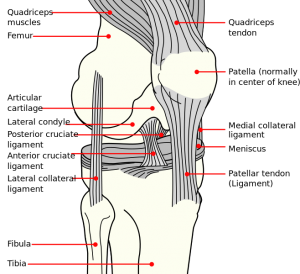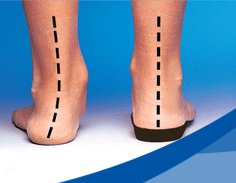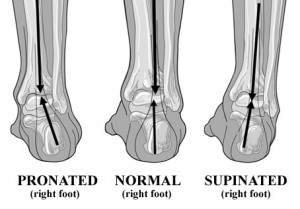 When it comes to knees, it is probably best to explore conservative options prior to undergoing surgery, according to some of the latest research (1, 2, 3). Certainly, it is important to be informed as to the potential benefits and risks of any treatment prior to making any decision about your health.
When it comes to knees, it is probably best to explore conservative options prior to undergoing surgery, according to some of the latest research (1, 2, 3). Certainly, it is important to be informed as to the potential benefits and risks of any treatment prior to making any decision about your health.
There are many different pain generating structures in the knee (including the cruciate ligaments, collateral ligaments, menisci, muscle tendons, bursae, etc). The first step before entering any treatment program is to establish a diagnosis as depending on the type of injury, the recommended treatment may differ. Seek a chiropractor or other musculoskeletal professional in your area.
Conservative Options:
Chiropractic care: Chiropractors are biomechanical experts who can not only establish the diagnosis but can deliver conservative forms of care. The goals are to restore mechanical balance / alignment in your body such that no one area is being overworked, to relieve pain without medication, to improve function and to accelerate your body’s natural ability to heal.
Pain relieving modalities: Electrical stimulation and acupuncture are both great choices for relieving knee pain without the use of drugs. These are especially helpful during the acute phase of recovery when there is usually considerable pain and inflammation. Depending on the condition, ice or heat can also work well.
Targeted rehabilitation: Following the acute phase, rehabilitation becomes important. Optimal knee function requires muscular balance and both flexibility as well as stability. Rehabilitation involves strengthening the muscles that are relatively long/weak and stretching muscles that are relatively tight/strong.
Soft tissue therapy: Soft tissue therapy can help break down scarring and adhesions from injuries that may otherwise compromise normal range of motion and function. It also temporarily increases circulation in the area to enhance healing.
Activity modification: Sometimes too much activity, or not enough, or poor form during an activity can result in aggravation of symptoms. In addition certain types of activities are not as safe for your knees (such as high impact sports or activities on an uneven terrain). That being said, some amount of activity is necessary as it flushes fluids through the joints, carrying nutrients and removing metabolic wastes. One of the best things for osteoarthritis, for example, is low impact range of motion exercise (such as swimming).
 Custom orthotics: Orthotics are special insoles for your shoes. Custom made orthotics are specially constructed to correct the alignment of your feet and to improve shock absorption so there is less impact through your joints. Because the knees are functionally connected to the feet, poor alignment of the feet can cause or contribute to knee pain (or pain higher up in the kinetic chain). A common contributing factor to knee injury is overpronation. Overponation causes the longitudinal arch to drop which results in an inward torsion of the knee (creating more tension on the MCL and medial meniscus and compression of the lateral knee joint space). Over time, this suboptimal loading can result in pain or injury.
Custom orthotics: Orthotics are special insoles for your shoes. Custom made orthotics are specially constructed to correct the alignment of your feet and to improve shock absorption so there is less impact through your joints. Because the knees are functionally connected to the feet, poor alignment of the feet can cause or contribute to knee pain (or pain higher up in the kinetic chain). A common contributing factor to knee injury is overpronation. Overponation causes the longitudinal arch to drop which results in an inward torsion of the knee (creating more tension on the MCL and medial meniscus and compression of the lateral knee joint space). Over time, this suboptimal loading can result in pain or injury.
Appropriate footwear: Choose shoes that are appropriate for the activity with good support, stability and shock absorption.
Ideal body weight: Reaching your optimal body weight if you are overweight, will help lessen the compression though your knees as well as other joints in your body and reduce the risk for osteoarthritis (4).
Knee brace or athletic tape: Using a knee brace or athletic tape while performing activities can help provide passive support to the knee and proprioceptive feedback. For injuries involving ligament damage, there is often a loss of joint position sense (proprioception) due to damage to nerve endings. This can set one up for future injury. Athletic tape provides more stimulation to the skin receptors to enhance your joint position awareness.
Glucosamine supplementation: Glucosamine is a natural substance the body makes that supports the health of joint cartilage.
Anti-inflammatory diet: Different foods are metabolized differently, some promoting inflammation and others reducing it. Having an anti-inflammatory diet will help rid your body of excessive inflammation and help to reduce pain naturally.
Have patience: Depending on the nature and severity of the problem, it may take several weeks or even up to a year to reach maximal recovery.
-
Moseley JB, O’Malley K & Petersen NJ, et al (2002). A controlled trail of arthroscopic surgery for osteoarthritis of the knee. N Engl J Med. Jul11;347(2):81-8.
-
Katz JN, Brophy RH & Chaisson CE, et al (2013). Surgery versus physical therapy for a meniscal tear and osteoarthritis. N Eng J Med; Mar18.
-
Kettunen JA, Harilainen A & Sandelin J, et al. (2007). Knee arthrooscipy ad exercise versus exercise only for chronic patellofemoral pain syndrome: a randomized controlled trail. BMC Medicine. 5:38
-
Felson DT, Zhang Y & Anthony JM et al. (1992). Weight loss reduces the risk for symptomatic knee osteoarthritis in women. The Framingham Study. Ann Intern Med. 1;116(7):535-9.